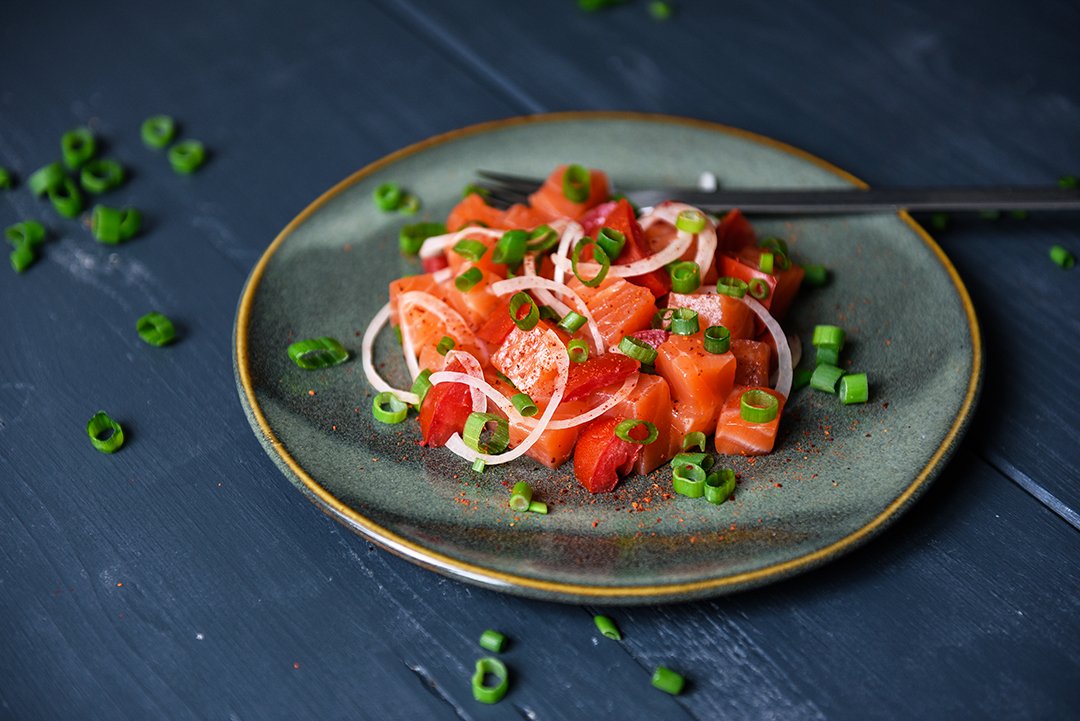Hawaiian Lomi Salmon
My mother makes fantastic gravad lax. It's one of my family's favorite dishes whenever the whole bunch gathers to feast. When I was younger, I would watch her prepare it and it fascinated me how she managed to turn two raw salmon fillets cured only with salt, sugar, dill, pepper, and juniper berries into something so fine and flavorful. After a few days they were firm yet tender, with hints of the sea yet at the same time tasting slightly sweet - it felt like magic. Salt-curing fish was the only way to preserve the daily catch from the sea in the pre-fridge era. It's deeply rooted in various cuisines, and thanks to its taste and texture, oily salmon remained a popular candidate keeping this ancient technique alive. Beyond gravad lax!
Alana Kysar had already introduced me to a new fish recipe when I met her in LA for our Meet In Your Kitchen feature back in 2017. Her Ahi Poke Bowl expanded my repertoire of recipes that use the fruits of the sea without adding too many ingredients, which I prefer, especially in summer. Her poke was quick to prepare and extremely delicious, and I immediately knew that I'd always want to go back to Alana's 'Hawaiian kitchen in LA' whenever I'd get the chance. In the meantime, she was busy and put together the most scrumptious cookbook: Aloha Kitchen. The book feels like having Alana in my kitchen and of course, I couldn't help but go straight for her recipes celebrating the sea.
Although Alana told me that Lomi Salmon is a side dish, traditionally served with poi - pounded, steamed, and peeled taro (kalo) root - or rice, or kalua pig (you can find all these recipes in her book!), I dared to turn it into a main, and almost ate it all by myself. The salmon is cured in salt for 24 hours and then soaked in water for 1 hour. Then it's ready to be used and assembled in just a few minutes.
Lomi Salmon is so pure, so good, it respects and puts the spotlight on each single ingredient; and there aren't many. Exactly this kind of cooking became my favorite way of enjoying food over the years. No distraction. Here, it's just the sea, chunky, tender salmon with a subtle saltiness that - to my surprise - is not overpowering, plus the sharpness of onions, juicy, fruity tomatoes that mellow them, and peppery hints from the chili flakes (Alana suggests gochugaru, Korean red chili pepper flakes, but I only had the more subtle Piment d'Espelette in my spice box). Just keep in mind, these kind of recipes using a handful of ingredients only really work if you go for high quality ingredients - to maximize flavor and pleasure. If you follow this rule, it's heaven.
Leafing through the colorful pages of Aloha Kitchen not only made me want to hop right on a plane and visit Alana's home islands, it also made me want to cook all the food that this inspiring woman put together. Alana was born and grew up in Hawai'i. Her life there, her family's stories and their recipes shaped her style of cooking that's as versatile as her home islands' culture: a rich melting pot, influenced by Polynesian settlers, by British, Spanish, Chinese, Japanese, Portuguese, Korean, and Filipino immigrants, explorers, workers, and sailors, all of them leaving marks in the islands' eclectic food culture. The local recipes are fresh and hearty, complex and simple, there's tender meat, light seafood, dumplings, noodles, and veggies. It's a vibrant kitchen cosmos that proves that we are at our best when we allow cultures and traditions to mix and create pure delicious beauty!
Lomi Salmon
from Aloha Kitchen by Alana Kysar, Ten Speed Press, 2019
Mind that the salmon needs to be cured for 24 hours and then soaked in an ice-water bath for 1 hour!
225g / 1⁄2 pound salmon fillet, skinned and boned
50g / 1⁄4 cup Hawaiian salt (‘alaea) (I used my flaky sea salt from Gozo)
4 Roma tomatoes, seeded and chopped
2 small Maui onions, peeled and chopped (I used 1 medium yellow onion, cut in half and thinly sliced)
6 green onions, green parts only, chopped
1⁄4 teaspoon gochugaru (Korean red chili pepper flakes) (I used 1/2 teaspoon Piment d'Espelette)
Place the salmon in a nonreactive rimmed dish or pan large enough for the fillet to lie flat and evenly coat both sides with the salt. Cover the dish with plastic wrap and refrigerate for 24 hours.
The next day, prepare an ice-water bath by filling a large bowl with a handful of ice and water.
Rinse the salt from the fish and soak the fish in the ice-water bath for 1 hour. Slice the salmon into 0.5-to 1.25-cm / 1⁄4-to 1⁄2-inch cubes and place them into a nonreactive bowl. Add the tomatoes, Maui onions, green onions, and gochugaru and gently toss with your hands. Cover the bowl with plastic wrap and refrigerate for several hours before serving.







